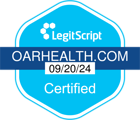The Grass Roots Community Evolving The Sinclair Method

In This Article
Oar Health had the opportunity to speak with Steve Wagner, a host of TSM Meetups and advocate of medication-assisted treatment for alcohol use disorder (AUD). Wagner is also one of the supporters behind TSM 2.0, an evolution of The Sinclair Method (TSM).
You may be familiar with The Sinclair Method as an evidence-based practice for treating alcohol use disorder, invented by Dr. John D. Sinclair. The framework uses targeted naltrexone as its north star.
- An individual using The Sinclair Method takes naltrexone an hour before having a drink
- Naltrexone blocks the euphoric effects of alcohol
- This causes someone to drink less and, eventually, have no alcohol cravings
- Over time, the brain stops associating alcohol with pleasure, a process called extinction
The Sinclair Method has gained recognition as an effective approach for managing alcohol use disorder. Roy Eskapa's book The Cure for Alcoholism: Drink Your Way Sober Without Willpower, Abstinence, or Discomfort helped popularize the method. The Sinclair Method has also amassed 192.6 million posts on TikTok, pointing to its recent growth.
However, there is an ongoing shift within the community toward a more inclusive and flexible version of this method—dubbed TSM 2.0 by its supporters. This evolution offers more personalized support, going beyond the traditional Sinclair Method.
Wagner approaches how he helps others from his former lived experiences of deep addiction. When Wagner first tried to get sober, he faced seizures and hallucinations, which led to a near-death experience. As far as Wagner could see 11 years ago, there were only two roads he could take: abstinence or death. He chose to live, and though recovery was, at times, grueling, he left the hospital with the question, “What can I offer others going through this?”
Wagner would advise anyone that almost dying is not a viable recovery path. “Three years ago, I came across The Sinclair Method and knew it was something I could support,” Wagner said. The science made sense to him.
Wagner believes in the method’s success so much that he hosts weekly groups and moderates online spaces such as the /alcoholism_medication subreddit, which has 23,000 members.
What Is TSM 2.0?
One lesson that became clear to Wagner is that sobriety alone was not enough—healing requires support around the underlying causes of addiction. This insight became the foundation for his involvement in TSM Meetups and eventual advocacy for TSM 2.0.
“Our bedrock is shame-free, nonjudgmental, evidence-based, employment of solutions to resolve AUD, whether you're taking naltrexone daily with an abstinence view or you're taking it targeted because you want extinction—they're not mutually exclusive,” Wagner explained.
The elements of TSM 2.0 are similar to the traditional Sinclair Method, but are more nuanced. At the heart of TSM 2.0 is the belief that there is no one path or right way to recovery. Unlike the traditional Sinclair Method, which focuses on blocking alcohol’s euphoric effects, the new approach encourages both targeted and daily use of naltrexone based on individual needs. So whether someone’s goal is abstinence or controlled drinking, TSM 2.0 offers flexibility.
This approach also emphasizes the importance of psychosocial support—a key aspect Wagner believes is often overlooked by the traditional Sinclair Method. While the original framework suggested that therapy wasn’t necessary, TSM 2.0 integrates methods to address the root causes of addiction such as trauma and mental health challenges. It helps people personalize strategies to cope with day-to-day stressors.
“Many people find resolving an addiction is easier to do within a supportive mutual help group. The more evidence-based treatments that help resolve AUD, the better,” Wagner said.
One distinction between the traditional Sinclair Method and TSM 2.0 is the support of redosing. Wagner pointed out that the traditional Sinclair Method does not emphasize the need for redosing during long drinking sessions. In contrast, TSM 2.0 believes that redosing may be necessary for some individuals, especially those drinking over extended periods.
The community behind TSM 2.0 also believes that you can tailor naltrexone to personal patterns. They believe that someone prone to drinking in the evening may need to take the medication later in the day rather than first thing in the morning—habits vary. They consider that this flexibility is crucial to help building sustainable routines that align with someone’s lifestyle and drinking triggers.
Misusing naltrexone, or noncompliance, can result from misunderstanding how the medication works. TSM 2.0 encourages users to experiment with dosing times and strategies, giving people greater control over their recovery journey.
Naltrexone has preventative powers, Wagner noted. “It can help people circumvent deaths and physical injuries that stem from alcohol misuse.” He also believes it can help prevent someone from developing severe alcohol use disorder down the line. He hopes that the broader availability of naltrexone could also thwart alcohol-related issues, including violence and accidents, by curbing excessive drinking before it escalates.
As a result, Wagner advocates for greater accessibility of naltrexone, pointing out how it could, someday, be over the counter and as readily available and as stigma-free as nicotine patches.
The TSM Meetups Community
The moderators behind TSM Meetups gradually developed TSM 2.0 to respond to attendees’ needs. Support groups like TSM Meetups allow people to share their experiences and learn from one another. These groups serve as crucial educational resources, offering guidance on adjusting naltrexone use to fit personal needs. Depending on who is online, support can be 24/7 through Discord.
TSM 2.0 emerges as a rejection of the rigidity of some recovery communities. Wagner recalls witnessing many debates in forums around using naltrexone outside traditional protocols, such as everyday use. He finds that former skeptics now embrace TSM 2.0 after seeing its benefits.
TSM 2.0 emphasizes flexibility, support, and prevention. This approach recognizes that recovery is not one-size-fits-all and encourages individuals to experiment with what works best for them. By providing a judgment-free community and advocating for broader access to naltrexone, TSM 2.0 offers a path forward for those struggling with alcohol. Whether through targeted or daily use, the goal remains the same: helping individuals find recovery.
You can find revised guidelines for taking naltrexone or other medications for AUD through the Substance Abuse and Mental Health Administration’s (SAMHSA) Treatment Improvement Protocol (TIP) 49.
About The Author
Xenia Ellenbogen (she/they) is a journalist specializing in health, mental health, and wellness. Her writing has appeared in publications such as Everyday Health, Well+Good, Rewire News Group, Prism, and more.






